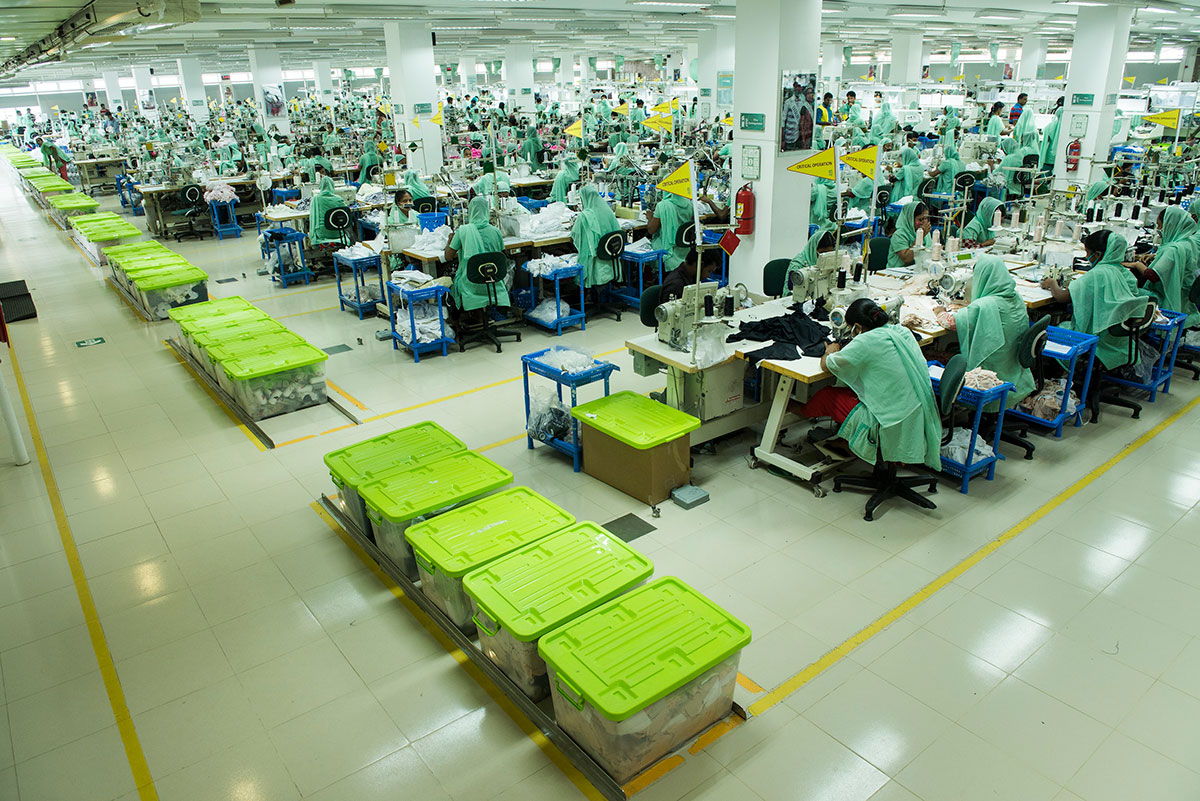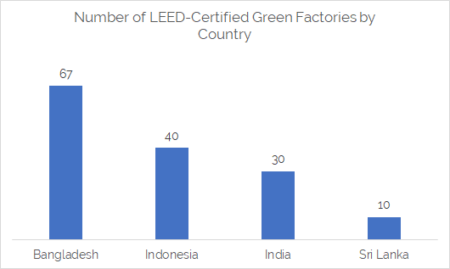GET IN TOUCH
- Please wait...

Despite being a developing country with a ready-made garments sector that is focused on cheap production, Bangladesh leads the world in “green RMG”.[2] Green RMG, the increase of which has also been termed the green revolution, refers to environmentally-sustainable production practices in the sector. It includes waste management, energy efficiency, and water conservation. As concern for climate change rises globally, producers, buyers, and consumers are all becoming aware of the transparency and implications of the apparel industry supply chain.
The RMG industry dominates Bangladesh’s exports with a share of 83% and it grew at a rate of 8.76% to reach exports of $30.6 billion in 2018.[1] As one of the most important industries of the economy, the RMG sector has a unique pressure upon it to adjust to global trends and stay competitive.
While incidents like Rana Plaza painted the Bangladeshi RMG industry as unsustainable and unsafe, it has actually been leading the green revolution. Not only does Bangladesh have the highest number of LEED-certified factories [2], but it also has the highest-rated LEED Platinum denim factory, knitting factory, washing plant, and textile mill in the world.[3] With fast fashion threatening to increase the environmental footprint of the industry dramatically, it is now more necessary than ever to promote green practices.
The global apparel manufacturing industry was valued at $658 billion in 2018, growing at a rate of 4.6% over the past five years.[4] As a result of its size, the apparel industry accounts for 6.7% of total global carbon emissions.[5] Textile mills generate around one-fifth of the world’s industrial water pollution.[5] Moreover, as global demand rises and shifts towards synthetic fibres from natural fibres, this footprint is expected to increase.
Sustainability is increasingly becoming a buzzword in global fashion, with high-end brands using recycled fabrics in their latest designs. Forty-three brands, including companies like Adidas and Target, pledged to reduce their Green House Gas (GHG) emissions by 30% by 2030.[7] Gucci’s parent group Kering, which also owns other high fashion brands such as Yves Saint Laurent and Balenciaga, announced in September that it would become carbon-neutral in its operations and entire supply chain. H&M has set a goal to use 100% organic cotton for all its products by 2020.[8] As one of Bangladesh’s largest buyers, H&M’s shift in strategy to sustainability is a crucial development for Bangladesh.
Global trends in international textile manufacturing include the incorporation of technology through methods such as lean manufacturing, digital energy management, and automation. The adoption of preferred fibre materials, such as synthetics or recycled fibres, reduce the creation of micro-plastics which harm ocean life and are difficult to dispose of properly.
Both consumers and executives alike are starting to see sustainability as a necessity. However, this is in stark contradiction to the rapid rise of fast fashion, a rapid and cheap form of production and consumption focused on e-commerce that has large-scale and harmful environmental impacts.
Fast fashion has increased the consumption of apparel as the number of garments purchased by the average consumer increased by 60% and halved the lifetime of an average clothing item.[9] While this translates into higher sales and production, it also means a more damaging effect on the environment as fast fashion depends on e-commerce, creating a high carbon footprint from shipping. Carbon emissions could increase by 70% and water consumption by 20% if fast fashion continues its growth at current environmental impact rates.[9]
The key issues for the factories in terms of environmentally-friendly practices are the depletion of groundwater, waste management of both chemicals and solid wastes, energy efficiency, and surface water pollution.
Textile production in Bangladesh is extremely water-intensive, using 200-250 litres per kilogram of fabric produced, whereas the global standard is 60-70 litres. About 70% of this water is sourced from groundwater.[6] The fibre production, yarn preparation, and dyeing processes are where most environmental impact takes place.
There are 91 LEED-certified factories in Bangladesh, which is higher than any other country.[2] Of the 10 highest rated LEEDS certified factories, six are located in Bangladesh.[1]The LEED (Leadership in Energy and Environmental Design) certification, awarded by USGBC, is considered to be the global standard of compliance and safety.

FIGURE: Number of LEED Certified Green Factories / Source: USGBC
To promote green practices, the Bangladesh Garments Manufacturers and Exporters Association (BGMEA) has opened a separate Environmental Cell. Initiatives include the Partnership for Cleaner Textile, called the PaCT Project, and TREES, among many others.
PaCT is a partnership among the International Finance Corporation (IFC), BGMEA, the Embassy of the Kingdom of Netherlands, and several global apparel brands. It has partnered with over 200 factories to date to implement resource conservation practices, resulting in cumulative cost savings of approximately $16.3 million.[10] Zero Discharge of Hazardous Chemicals, ZDHC, is also a shared commitment between major retailers and brands to move towards its titular goal by 2020.
The BGMEA has also worked to raise awareness about saving water and energy among its members through posters, seminars, and workshops. The most well-known and highest-rated factories have been crucial proponents of this green revolution.
Despite being one of the lowest carbon emitters, Bangladesh is highly exposed to the impacts of climate change. As developed countries start prioritising environmental impact through legislation and changing consumer patterns, poorer countries are at risk of falling behind due to an inability to adapt.
While the high number of LEED certifications is encouraging and a point of pride, these factories form a small fraction of the total 2,500+ that operate in the industry. To increase the scale of the green revolution, government policy will need to support the shift to sustainable practices. Green financing is a crucial step here that will encourage investment in environmentally-friendly technologies.
The achievement of green practices in RMG is also crucial for the achievement of several of the United Nations Sustainable Development Goals, especially SDG 12 of Responsible Consumption and Production and SDG 13 of Climate Action. It is also necessary to market the advancements in sustainability to foreign buyers and consumers. The green revolution may be the push needed by Bangladesh to take over China’s share in the market, as the latter suffers from the blow of the US-China trade war and shifts to higher-value manufacturing.
Mondrita Rashid, Trainee Consultant at LightCastle Partners, has prepared the write-up. For further clarifications, contact here: [email protected].
Our experts can help you solve your unique challenges
Stay up-to-date with our Thought Leadership and Insights